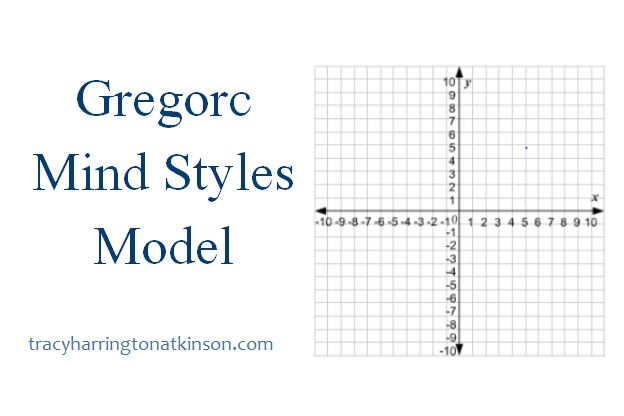Gregorc Mind Styles Model
Students are extraordinary teachers. They speak. They constantly tell us how our expectations, objectives, curriculums, and instructional strategies affect them. We need to look to our students to tell us why learning takes place.
~Anthony Gregorc
Anthony Gregorc started his career with a bachelor’s degree from Miami University. He continued on to complete a master’s degree and a PhD from Kent State University. At the publication of this book, he owned a business called Gregorc Associates. 
Anthony Gregorc investigated the concept of duality embedded within western culture, western philosophy, religion and even psychology. He discerned two ends of a spectrum in the assimilation of and process of acquiring new knowledge. From this research, Gregorc (1977) defined two modes of learning which he called preference modes, leading to the development of the Mind Styles Model.
An assessment, The Gregorc Styles Delineator, was designed to determine the learning preference for the individual. The assessment contains forty questions which are designed to elicit explicit responses. The results were given in a similar manner to he Kolb Learning Styles Inventory, on a graphic model with two axis. The four different quadrants of learning preference modes within the Mind Styles Model are Concrete Sequential, Concrete Random, Abstract Sequential and Abstract Random. An example of this assessment tool can be found on Anthony Gregorc website for his business: Gregorc Associates.
Concrete Sequential
The concrete sequential learner prefers hands-on learning experiences which engage each of the five senses. Learners prefer step-by-step, detailed directions. They learn best from organized lesson planning, presentations and instructional formats, avoiding chaos. This type of learner tends to be more submissive in learning situations, deferring authority.
Concrete Random
The concrete random learner is a spontaneous learner who quickly assimilates facts and knowledge. This learner relies heavily on their intuition to arrive at a conclusion. This learner prefers trial and error methodology to learner, enjoying the experimentation process. They tend to not seek for input from mentors, guides, teachers or others in leader positions.
Abstract Sequential
The abstract sequential learner is able to quickly learn through a variety of means, decoding verbal, written and visuals. Visuals are highly essential to this type of learner. They require learning environments which are organized, formatted and filled with valid knowledge.
Abstract Random
The abstract random learner collects information in a haphazard way, with little to no formal outline or direction. They are flexible in their learning environment, being able to learn best from verbal means. They will take the new information and provide they are given time to reflect and ponder, will organize the information into a pattern or schema which makes sense to them.
By Tracy Atkinson
 Tracy Atkinson, mother of six, lives in the Midwest with her husband and spirited long-haired miniature dachshunds. She is a teacher, having taught elementary school to higher education, holding degrees in elementary education and a master’s in higher education. Her passion is researching, studying and investigating the attributes related to self-directed learners and learning styles. She has published several titles, including MBTI Learning Styles: A Practical Approach, The Art of Learning Journals, Calais: The Annals of the Hidden, Lemosa: The Annals of the Hidden, Book Two, Rachel’s 8, The Personal Pursuit of Perfection and Securing Your Tent. She is currently working on a non-fiction text exploring the attributes of self-directed learners: The Five Characteristics of Self-directed Learners. Check out her online courses at: Udemy, Teachable and Thinkific.
Tracy Atkinson, mother of six, lives in the Midwest with her husband and spirited long-haired miniature dachshunds. She is a teacher, having taught elementary school to higher education, holding degrees in elementary education and a master’s in higher education. Her passion is researching, studying and investigating the attributes related to self-directed learners and learning styles. She has published several titles, including MBTI Learning Styles: A Practical Approach, The Art of Learning Journals, Calais: The Annals of the Hidden, Lemosa: The Annals of the Hidden, Book Two, Rachel’s 8, The Personal Pursuit of Perfection and Securing Your Tent. She is currently working on a non-fiction text exploring the attributes of self-directed learners: The Five Characteristics of Self-directed Learners. Check out her online courses at: Udemy, Teachable and Thinkific.

Comments are closed